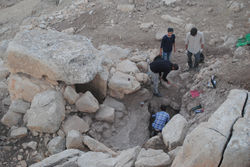Jebel al-Mutawwaq
 |  |  |  |  |
|---|---|---|---|---|
 |
Season 2021
Excavation results of the Spanish-Italian expeditions
During the 2021 archaeological season, the Italian team opened two areas of excavation, both enlarging trenches already indagated in 2019: one in Area EE and one in Area C Est. The Spanish team opened Area D.
In Area C Est a new trench (5 x 10 m) was opened toward east: the aim was to reach the eastern wall of the large sacred structure called Great Enclosure, After the first week of excavations, the bedrock, corresponding to the natural floor used during the EB I (3500-3100 BCE) was exposed in the whole area: between the several pottery sherds and flint tools recovered on the floor, a small miniaturistic jar similar to others discovered in Cave 1012 was find, dating the last use of the Enclosure to EB IB (3241-3104 BCE).
Close to the wall W.102 four rock cut installations have been discovered: from the pottery sherds inside of them, it’s probable that they were used to located vessels filled with alimentary offerings as confirmed by che animal bones and vegetal remains. Thanks to the C14 analysis of a burnt olive seed, the datation is EB I (3521-3367 BCE). Between che animal bones, the presence of a large vertebra possibly related to a cow is very interesting because it could be the first evidence of cattle breeding related to an increasing level of sedentarization in the site from EB IA to EB IB.
During the excavation, it was noticed that the easternmost part of the perimetral wall of the Great Enclosure, W.204, was built in a different construction technique, more regular and with smaller stones: this could mean that this part of the Enclosure was rebuilt in a second phase. Also, at least four small walls, made of a single lines of stones, were identified: the small rooms, built directly against W.204, were probably used in a later time for domestic or working spaces: unfortunately, due to the absence of pottery, it wasn’t possibile suggest a more specif datation.
In Area EE the new trench (10 x 15 m) was opened including cave C.1210, focusing in the northern portion of the area. The first aim was to investigate the two lateral chambers of the cave, left unexcavated in 2019, to understand the function of the structure and the space in front of it. The excavation of Area EE allowed to deepen the comprehension of the settlement and its relationship with the necropolis: despite it remains unclear the exact function of the cave C.1210 due of the robbing activities performed in modern times, it’s important to notice that the cave was connected toward West with another cave, possibly a cistern, suggestint a function different from the funerary or the domestic use. Also, the proximity of another water pit close to the Southern settlement door, in the same portion of the site, may suggest a use connected to water supply.
Close to the cave there was a huge apsidal structure (B.1214) with ovoidal shape, as most of the EB I structures identified in the village, with N-S orientation: the building was probably used for food producting activities in a public context. In the structure were found stone flat slabs togheter with a cupmark and grinding stones: also, there where lots of EB I pottery fragments of large storage jars and an entire limestone spindle whorl. All these findings. To better understand the structure it’s necessary to complete the investigation of the structure in the next campaing.

Describe your image

Describe your image

Describe your image

Describe your image